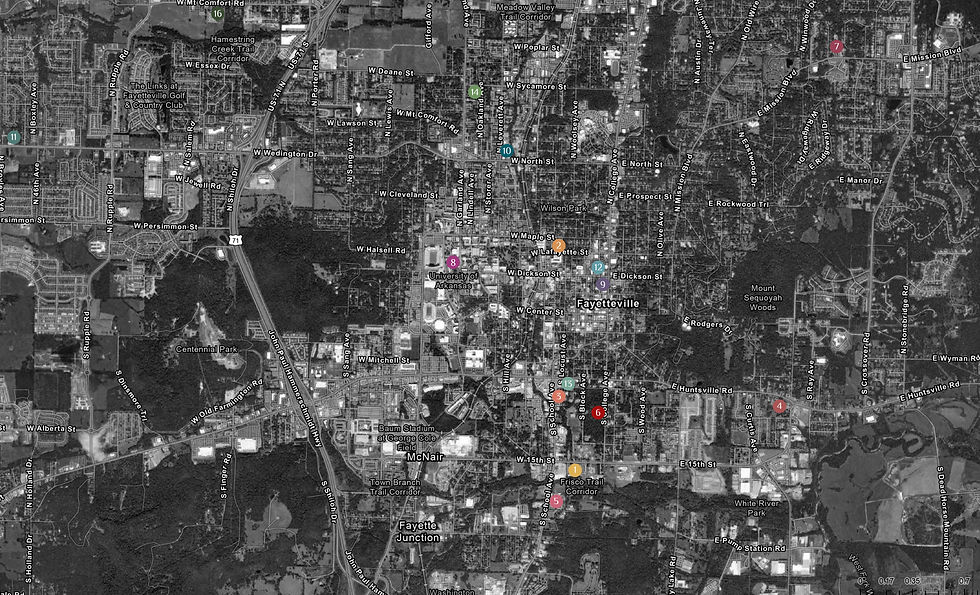Water + Light
- cnlents
- Oct 14, 2022
- 3 min read
Updated: Dec 11, 2022
Water and light are two of the most important resources on the planet. They affect all aspects of life for plants, animals, and humans. Due to this, maintaining the right levels, access, and quality of both light and water is critical. In Fayetteville, there are several initiatives in place to help make sure that the water meets these requirements. They include using a well-maintained water source, monitoring the water and sewage systems, clear ordinances to prevent contamination, and a few programs to discourage littering or polluting the water supply. The light pollution is much less regulated from what I was able to find. A few things are being done to help like increasing the number of lights in parking lots and on the trails for safety. Beyond this, how do these initiatives impact Fayetteville's overall environmental quality?
Breaking Down the Water:
Water Source:
Fayetteville's water comes from the Beaver Water District. This company gets its water from the Beaver Lake watershed and supplies treated surface water to four customer cities in NWA: Fayetteville, Springdale, Rogers, and Bentonville.
Fayetteville itself lies in 2 major watersheds; the Illinois River watershed and the Beaver Lake watershed. Because of this, there are over 100 miles of streams that run through the city. This makes managing stormwater very important to prevent flooding and polluted runoff. There are a few initiatives that encourage people to create rain gardens, use rain barrels, and other things to help prevent flooding. Several of these have been implemented since 2018 in response to the bad flooding the city experienced back in April of 2017.
Water Quality:

The yearly water quality report released by the city of Fayetteville shows how the water has been below federal limits for a while and typically continues to get better as the years go on. The report from 2021 can be seen on the right. It breaks down the different contaminants with Fayetteville's level, the source of the containment, and the maximum federal level. The city of Fayetteville has some of the healthiest water in all of Arkansas because of its source and the focus it puts on the water and sewage infrastructure.
The main community initiative that I could find that is tied to this maintenance and care is called Upstream Art. The purpose of this is to draw attention to storm drains with some small-scale murals to hope that the observer stops and thinks about where the water is going before discarding any type of pollutant into the drain.
Into the Light:
The city of Fayetteville has health initiatives involving many, many different aspects that influence the environment, but it seems to be lacking when it comes to dealing with light pollution. It does have a few solar panel projects with the goal of decreasing the use of non-renewable energy sources. It also had a Street Light Pilot Project in 2018 that installed LED light fixtures in a specific neighborhood to decrease the number of dark spots on the road and increase the safety of people walking at night. From this pilot program, they found that 46% fewer responders noticed dark spots on the streets and 36% more responders felt safe on the sidewalk at night. But why this wasn't expanded I am not sure.

Light Pollution:
Above is a map of the level of light pollution in Fayetteville according to Clear Dark Sky. As the colors go from blue to red on the rainbow, that indicates that the sky is darker and darker. There is a pretty high level of light pollution in Fayetteville, Springdale, and Rogers. While this is to be expected in larger towns, is there anything in Fayetteville specifically that may be making its number higher? In Springdale, there are a lot of industrial and manufacturing plants so I assume that has something to do with why its levels are so high. Using my intuition and personal experience, I am going to guess it has something to do with the university with its numerous parking lots and sports facilities that are lit up a majority of the time. For example, one of the main commuter lots is lit up by huge street lights all night, every night. While I know this is a safety thing, the light is very bright and shines in the window of my apartment every night. Another example is the Razorback Football Stadium. It is lit up all the time and every night before a football game the entire stadium is lit up red. Making the entire sky in that area red. While this does look cool, I wonder what effect it is having on the overall light pollution in Fayetteville. Overall, I think the high amount of light pollution in Fayetteville has something to do with the university and the large number of parking lots that are lit up every night on campus and around Fayetteville in general.
Resources:






Comments